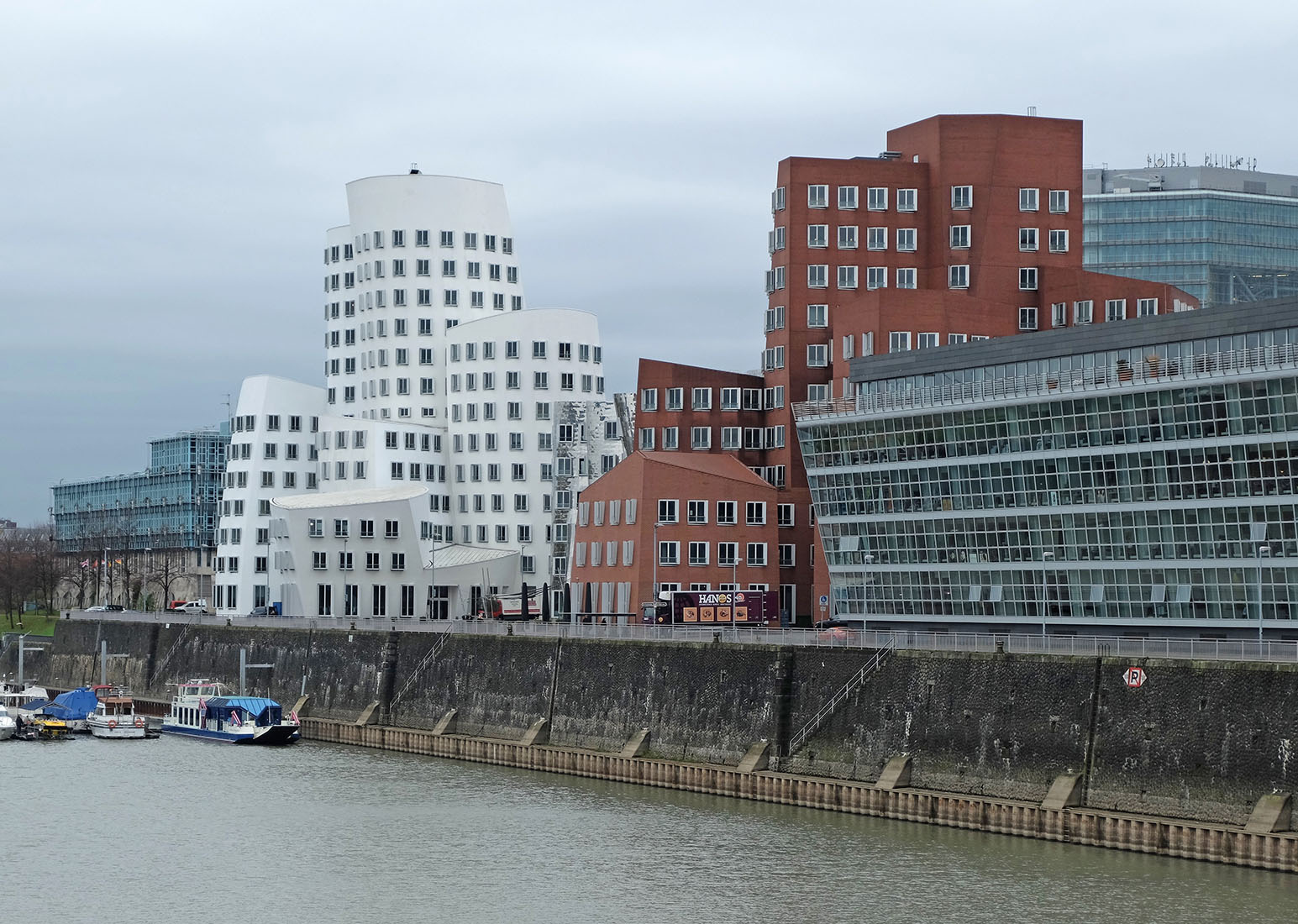 |
 |
 |
 |

Neuer Zollhof
Neuer Zollhof 2-6, Düsseldorf
1996 - 1999
The
building complex "Neue Zollhoff", located at the Düsseldorf Media
Harbour, was built according to a design by the US American architect Frank O. Gehry.
Originally, the 1990 architectural competition for the construction on
the site of the old Zollhof was won by the British architect Zaha
Hadid. However, the deconstructivist design by Zaha Hadid was not been
implemented. Instead, from 1996 - 1998 the three buildings were
realized by Frank O. Gehry in cooperation with a German partner agency.
The division into three building volumes allows to receive the desired
access to the port for the residential area behind. Today the building
is considered as a landmark of the area. Each of the three
constructions has a different appearance so that an ensemble of a
white, a reddish brown and a metallic luster volume is created. The
stainless steel facade of the central building reflects the two
neighbors. The buildings are characterized by the striking curves of
the façades. The tallest building features 14 floors and reaches a
height of almost 50 meters.
Der Neue Zollhof ist ein Gebäudeensemble im Düsseldorfer Medienhafen, das nach einem Entwurf des US amerikanischen Architekten Frank O. Gehry errichtet wurde. Den 1990 ausgeschrieben Wettbewerb für den Neubau auf dem Gelände des abzubrechenden Zollhof hatte ursprünglich die Architektin Zaha Hadid gewonnen. Allerdings wurde der dekonstruktivistische Entwurf Zaha Hadids nicht umgesetzt. Stattdessen wurden die drei Gebäude in den Jahren 1996 bis 1998 von Frank O. Gehry in Zusammenarbeit mit einem deutschen Partnerbüro erbaut. Die Aufteilung in drei Gebäudevolumen erlaubt es den gewünschten Zugang zum Hafen für das dahinter liegende Wohngebiet frei zu halten. Heute werden die Gebäude als Wahrzeichen dieses Gebietes betrachtet. Jeder der drei Bauten weist ein anderes Erscheinungsbild auf, so dass ein Ensemble aus einem weissen, einem rotbraunen und einem metallisch glänzenden Volumen entsteht. Dabei spiegeln sich in der Chromstahlfassade des mittleren Gebäudes die beiden Nachbarn. Die Bauten sind geprägt von den auffallenden Krümmungen der Fassaden. Das höchste Gebäude weist 14 Stockwerke auf und erreicht eine Höhe von knapp 50 Meter.
Der Neue Zollhof ist ein Gebäudeensemble im Düsseldorfer Medienhafen, das nach einem Entwurf des US amerikanischen Architekten Frank O. Gehry errichtet wurde. Den 1990 ausgeschrieben Wettbewerb für den Neubau auf dem Gelände des abzubrechenden Zollhof hatte ursprünglich die Architektin Zaha Hadid gewonnen. Allerdings wurde der dekonstruktivistische Entwurf Zaha Hadids nicht umgesetzt. Stattdessen wurden die drei Gebäude in den Jahren 1996 bis 1998 von Frank O. Gehry in Zusammenarbeit mit einem deutschen Partnerbüro erbaut. Die Aufteilung in drei Gebäudevolumen erlaubt es den gewünschten Zugang zum Hafen für das dahinter liegende Wohngebiet frei zu halten. Heute werden die Gebäude als Wahrzeichen dieses Gebietes betrachtet. Jeder der drei Bauten weist ein anderes Erscheinungsbild auf, so dass ein Ensemble aus einem weissen, einem rotbraunen und einem metallisch glänzenden Volumen entsteht. Dabei spiegeln sich in der Chromstahlfassade des mittleren Gebäudes die beiden Nachbarn. Die Bauten sind geprägt von den auffallenden Krümmungen der Fassaden. Das höchste Gebäude weist 14 Stockwerke auf und erreicht eine Höhe von knapp 50 Meter.
